Colombia Transit Oriented Development NAMA Selected for Funding
- Steve Winkelman
- Nov 15, 2013
- 5 min read
Today at the UNFCCC 19th Conference of Parties (COP) in Warsaw, the joint Germany-UK NAMA Facility announced the funding of the world’s first Transit-Oriented Development (TOD) NAMA in Colombia. CCAP will partner with Colombian Development bank FINDETER to deliver $20 million (USD) in technical and financial resources to catalyze the building of TOD neighborhoods in five cities across the South American nation. This multi-sector NAMA was developed through CCAP’s Mitigation Action Implementation Network (MAIN) project over the past two years in close coordination with FINDETER, the national Ministries of Transport, Environment, Housing and Planning, local officials, private developers, university researchers and local NGOs.
The TOD NAMA will transform urban development in Colombia, shifting how and where public and private investments are made to increase the environmental, economic and social return on Colombia’s continuing investments in mass transit and social housing ($9 billion over the past decade).

The Problem
Colombia’s innovative bus rapid transit (BRT) systems have become a global model for low-cost, sustainable urban transportation. But as the economy has grown and motorization has increased, the traffic and air pollution that the BRT systems had initially addressed began to creep back into many cities because of urban development generally not integrating with transit lines.
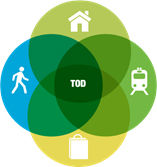
The Solution The fundamental “technology” of this NAMA is the TOD neighborhood – focused real estate development near transit stations where people can safely walk, live, work, shop and play. Key elements of TOD include high-quality pedestrian amenities, frequent public transit service and mixed-use development (retail, housing, commercial, services, public space). Empirical evidence indicates that people drive 30-70 percent fewer kilometers in TOD neighborhoods than in more sprawling, car-oriented development.
Colombia’s TOD NAMA will couple strategic investments in catalytic neighborhoods with policy innovation, jump starting a new public-private partnership law. The NAMA will create a project pipeline and a policy framework to engender broad replication by mobilizing additional private, national and international funds. Colombia has looked beyond the transportation sector to tap financial and policy resources from the housing sector. By Asking the Climate Question about housing investments, the NAMA will ensure that national policy goals for affordable housing and sustainable transportation work in harmony.
The TOD NAMA is the result of the articulated work of the Ministries of Environment and Sustainable Development, Transport, Housing and the National Department of Planning within the framework of the Colombian Low Carbon Development Strategy (CLCDS). The CLCDS is the Colombian national government’s development program to implement plans, projects, measures and policies that contribute to greenhouse gas (GHG) mitigation and strengthen economic and social development. The Ministries have developed a Transport Sector Mitigation Action Plan with prioritized mitigation actions, such as the TOD NAMA, which will lead Colombia to reach global requirements of efficiency, competitiveness and environmental performance in urban areas.
Colombia recognizes the need to diminish the obstacles that have kept the market from taking full advantage of the land development value generated by major public investments in transit infrastructure. The NAMA is designed to overcome important barriers to TOD implementation such as local investment gaps, imperfect public-private collaboration, inadequate urban policy integration and limited value capture and finance mechanisms. CCAP and FINDETER identified a variety of strategic TOD investment opportunities including a new Metro station, bike and pedestrian-related infrastructure, and enhanced public spaces. These opportunities in Cali, Medellin, Manizales, Bogota and Barranquilla include private-sector-driven redevelopment, mixed-use transformation of existing station areas, redesign of car-oriented infrastructure plans, and improvement of extremely low-income informal settlements.
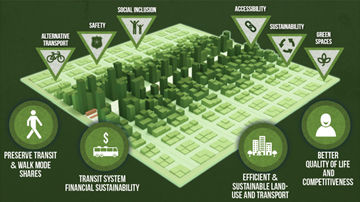
Environmental, Economic and Social Benefits
The TOD NAMA is expected to cut driving growth by 25-36 percent through changes in land use and travel patterns, and reduce annual GHG emissions by 3.6 to 5.5 MMTCO2 by 2040. It will save travelers time and money, and reduce traffic deaths. Governments and taxpayers will save money through reduced infrastructure costs, and private developers will find new investment opportunities (see CCAP’s Growing Wealthier). A FINDETER study concludes that the city of Barranquilla, could save $1 billion in infrastructure expenditures by shifting future development to TOD neighborhoods, while also decreasing vulnerability to flooding (i.e., Connecting the Dots). The Bogotá 21 study found that TOD could generate annual revenue of $500 million from land value capture mechanisms. The NAMA will leverage an expected $8 billion in future investments for public transport and social housing and many billions more in private development.
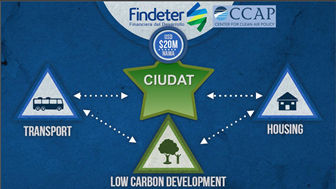
How the TOD NAMA Works
NAMA investments and technical assistance will be based on locally-articulated opportunities and needs for TOD implementation. It will support investments in specific urban development improvements (public space, transit, pedestrian and bike infrastructure) in cities across Colombia, starting with five catalytic neighborhoods in the first three years. The NAMA will integrate national and local transport and land use policies to address market barriers and attract to private TOD investment.
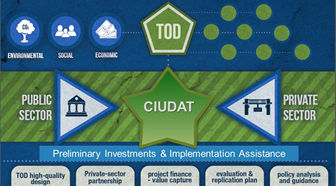
FINDETER and CCAP will serve as the Delivery Organization for the NAMA, tapping FINDETER’s experience in financing urban infrastructure and sustainable development and CCAP’s expertise in TOD, NAMAs and policy evaluation. Financial and implementation assistance will be conducted through a facility named CIUDAT (Centro para Intervenciones Urbanas de Desarrollo Avanzado hacia el Transporte), hosted by FINDETER and supported by the Universidad de los Andes and CCAP. CIUDAT will be overseen by an independent board staffed by senior representatives of key national ministries who will develop specific rules and selection criteria for investment and technical assistance. With national ministries at its side, FINDETER will be able to emphasize TOD in its $500 million Sustainable Cities program, leveraging public finance to catalyze private investment.
Financial and Implementation Assistance
CIUDAT will assess potential TOD investments considering factors such as: scale, local land use zoning frameworks, private sector engagement and coordination with national investments in transit and social housing. All proposals should be feasible in terms of bankable potential, come with strong political leadership, and demonstrate clear market demand for transit-oriented development.
Financial support can include:
Project implementation. High-quality design, market analysis, pre-construction planning, and construction of strategic infrastructure elements;
Public-Private collaboration. Developing RFPs on TOD implementation under the new public-private partnership law;
Finance development. Packaging funding proposals for domestic and international investors.
Implementation assistance can support:
Technical assistance on TOD implementation and increasing social and economic returns;
Value-capture finance mechanisms. Design of Tax Increment Financing and Business Improvement District fees;
Replication. Identify “pipeline” of TOD sites; Advance integrated policy mechanisms;
Evaluation. Data improvements and calculation of GHG, social and economic benefits.
Promising locations for TOD include:
• Cali: Redesigning the roundabout and BRT station area in the Green Corridor to put cars underground and create stellar pedestrian places • Medellin: Private sector plan for future Entre Orillas Metro station area • Bogota: San Bernardo future Metro and BRT station development • Barranquilla: Mixed-use in Parque de la Paz neighborhood • Manizales: San Jose Macroproyecto low-income housing project
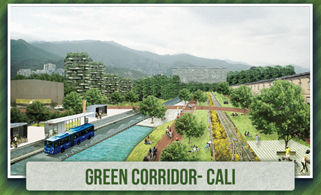
Long Term Results
The TOD NAMA will institutionalize TOD as the standard new template for urban development in Colombia. It will change the urban fabric of Colombian cities and provide long-term, low-carbon results by locking in efficient land use and travel patterns. TOD investments and policies will yield important returns in economic development, social equity, quality-of-life, energy security and climate resilience.
Under a TOD paradigm, as Colombia’s population continues to flow to urban areas they will be able to enjoy a comfortable lifestyle without the need for excessive private motor vehicle travel. The motorization growth rate will be reduced helping achieve GHG emissions reduction targets, reducing traffic and improving air quality.
As noted in the Warsaw Statement on Low-Carbon Transport and Sustainable Development, the International Energy Agency (IEA) estimates potential cost savings of $50 trillion through 2050 (infrastructure, vehicles fuels) with coordinated travel demand management and land use policies such as TOD, transit, pedestrian and freight system improvements.
Just as Bogota’s TransMilenio BRT served as a model for other Colombian and international cities, the Colombia TOD NAMA will provide valuable lessons to inform and inspire replication in developing countries worldwide as they strive for sustainable urban development and equitable prosperity.
This project is supported by the NAMA Facility on behalf of the German Federal Ministry for the Environment, Nature Conservation, Building and Nuclear Safety (BMUB) and the UK Department of Energy and Climate Change (DECC).
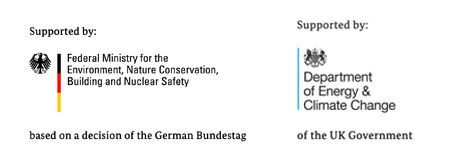





شيخ روحاني
رقم شيخ روحاني
الشيخ الروحاني
الشيخ الروحاني
شيخ روحاني سعودي
رقم شيخ روحاني
شيخ روحاني مضمون
Berlinintim
Berlin Intim
جلب الحبيب
https://www.eljnoub.com/
https://hurenberlin.com/